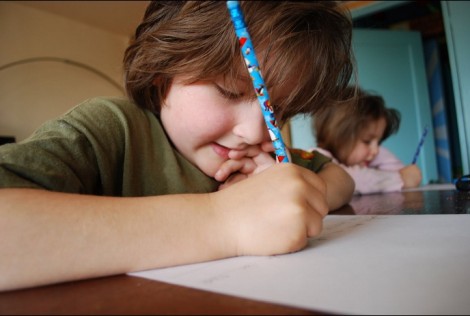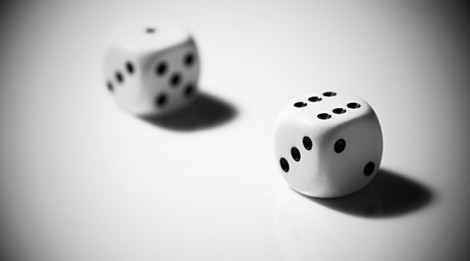 Ever find yourself telling people that you're just not good at maths? That maths isn't your strong point? That you just don't get numbers? Well if you've got a child at primary school, you're in a for a bit of a surprise.
Ever find yourself telling people that you're just not good at maths? That maths isn't your strong point? That you just don't get numbers? Well if you've got a child at primary school, you're in a for a bit of a surprise.
The old way of teaching maths at school was designed to produce legions of literate clerks to keep the books for the Empire. We don't need people to do that anymore. We have calculators, and spreadsheet programs on computers.
So the focus instead is now on helping children understand maths, and discover all the systems and patterns that can be found in the wonderful world of mathematics. This in turn will mean that later on they'll find concepts such as algebra relatively easy.
So as a parent, you're going to need to get to grips with all this new stuff too. And it doesn't mean you have to spend a lot of money on educational programs or resources. There are a few simple, cheap or free ways you can help your child become numerate.

Games
In Reception and Nursery, your child may not bring home more homework than their reading book. However, if they do get simple additions or subtractions to do, or number sequences, you can help them by just incorporating it into everyday life.
A fabulous way to do this is to make a game you can play together. My favourite is the lilypad game. Cut out some lilypad shapes - OK mine looked more like leaves. I'm not sure I know what a lilypad looks like.
Next, I printed off a sheet of little frogs, which I found on the internet. We used one dice to start with.
Each player has a lilypad. Roll the dice, and that's how many frogs you need to have on your pad. So if you roll a 5, you need to put five frogs on there. If the next number you roll is a 2, you need to take three frogs off.
We had a set time of five minutes, and the player who had the most frogs on their lilypad won!
What I liked about this game was that you can scale it up. As they learn more about numbers, you can use two dice. Or you can do it in multiplications of five or ten. So a Red frog might equal 5 frogs, and a blue frog could equal 10 frogs. A roll of the dice that shows a 6 and 4 would be 60 and 40.
There are also a lot of sites online with maths games that will help. One resource I've found useful are the games on this Maths Activities website.
 Number squares
Number squares
Put a Hundred square up in the main living room or room where they do their homework. A Hundred square is pretty much just that. A square that starts with the number 1, and ends in 100, with the first line going 1 to 10, and so forth down the grid. So that all the tens are in columns eg 10, 20, 30 etc.
Keep an eye out in pound shops, as many often have laminated number or Hundred squares for sale. Or just print one out yourself on an A3 sheet of paper. That's what we have in our lounge, and although the paper gets tatty, it still does the job.
You could go for a colour one, like this at Super Teacher Worksheets. Or something in black and white, and very plain, such as this 100s square.
The ones I use come from Sparkle Box. My son really liked the submarine graphics. The images print out just as well in black and white as they do in colour. Have a look at the four different types available HERE.
 What is a number line?
What is a number line?
If you're up to year 1, then you may have opened your child's maths homework book and been left scratching your head as the teacher directs them to use a number line. Yes that's happened to me too.
A number line is first used in schools by children to add or subtract numbers - the first 'operations' they will learn. But that's not the real purpose of a number line. Later on it will help with learning decimals, and fractions. And mathematicians use number lines too.
Draw a line, then segment that line from, say, 1 to 10. it doesn't need to be straight or evenly divided. To work out what 5 + 4 equals (see our froggie friend above), you start your pencil on the number 0 and then count along 5 steps - draw a 'hop' to this. Then do the same for the 4. You land on the number 9 and that's the answer.
If you get this in their homework book, it is important that you get your child to draw the number line and show the 'hops'. What the teacher wants to see are the 'workings out'. From this they can tell if the child is getting the concept of subtraction or addition.
In the new maths, there's a lot of emphasis on the 'workings out'. This seems daft to us, because surely it is getting the correct answer that is important?Not quite. We no longer need to add large columns of numbers because we have calculators.
So, when we were first learning maths, very little emphasis was given to understanding the concepts behind maths. As a result, when we were hit with formulas and algebra, it really did feel like we were being hit. Hard.
The aim of the new maths is to avoid that entirely.
 And that's just a taster
And that's just a taster
There's even more to come when your child moves up in school. Such as chunking and gridding for starters! Personally, I love the new way they teach long division and multiplication, it is really quite a lot easier once you grasp the concept.
There are three resources I've found immensely useful in helping understand my son's maths homework, and in finding ways to help him learn. First, I went on a numeracy course run by the Local Authority, at our school, on just this topic. Have a look on the noticeboard at your school.
Second, I got a book. Maths for Mums and Dads. I did buy this 18 months ago, and am only a third of the way into it. But it has a handy glossary right at the front so I can look up all these terms! And I figure I'll progress through the book as my son progresses through school.
And thirdly, the internet. Just do a search and you'll find all sorts of stuff. A friend recommends Mad4Maths for parents of key stage 2 children.


 What is a number line?
What is a number line? And that's just a taster
And that's just a taster




















Comments